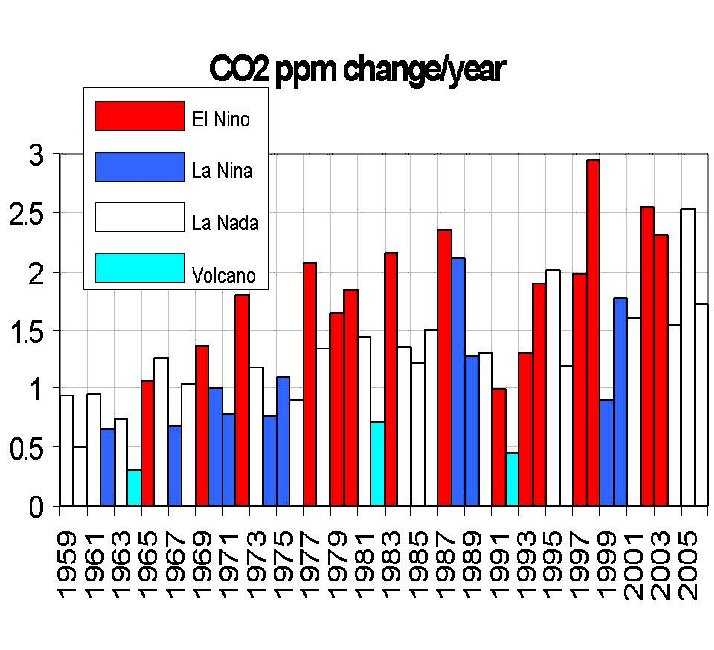By Joseph D’Aleo, Icecap
Carbon dioxide is 0.00038 or 0.038% of our atmosphere by volume. Only 2.75% of atmospheric CO2 is anthropogenic in origin. The amount we emit is said to be up from 1% a decade ago. Despite that increase, our annual contribution each year is just 0.00001 or 0.001% of our atmosphere by volume. Despite the increase in emissions, the rate of change of atmospheric carbon dioxide at Mauna Loa remains the same as the long term average (+0.45%/year). This is likely because the oceans are a far more important sink for excess carbon dioxide than generally accepted. If the atmosphere was a 100 story building, our anthropogenic CO2 contribution today would be equivalent to the linoleum on the first floor. By comparison, water vapor, a far more potent greenhouse gas, on average would occupy on average 1 floor and at times, especially in the tropics, up to 4 floors.
See in this brief paper, how the changes year-to-year relate to ENSO and volcanic eruptions rather dramatically which suggests the carbon dioixde in the atmosphere reacts rapidly to changes in the oceans and as Segalstad and others have speculated likely has a far shorter residence time in our atmosphere (5-7 years) than claimed by the IPCC (150-200 years). This could have a significant effect on the ability of climate models to forecast future levels of carbon dioxide and temperatures.

Notice a pattern? The annual rates of increase in carbon dioxide El Ninos tend to be more, La Nina less, volcanic years least.
For El Ninos the average increase has been 1.80ppm/year, La Ninas over 40% less at 1.03. For years after major volcanic eruptions (Agung, Mt St Helens, El Chichon, Pinatubo, Cerro Hudson) the average increase is just 0.61 ppm. For ENSO (eliminating major volcano years), the Pearson correlation is a moderately strong 0.67 with the CO2 changes.
The reason the rate increases during El Ninos is that El Ninos cause global land and sea temperatures to rise. As oceans warm, they release more of the stored carbon dioxide. The CO2 rate of increase diminishes after La Ninas and volcanic eruptions as land and sea cool. As the oceans cool, they take in more carbon dioxide.
This rapid response supports the notion of a shorter lifetime for CO2 (5 to 7 years) as suggested by Segalstad and 35 other studies he compiled, far short of the 150-200 years the IPCC claims. If this more rapid atmospheric response and shorter residence times are correct, it is another flaw in the global climate models that may exaggerate the changes upcoming.




